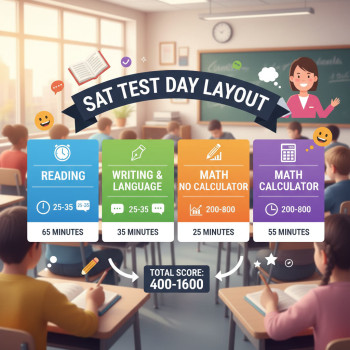The Student Psychology of Seeing SAT Scores Improve
There’s a peculiar kind of magic that happens when a student logs into their practice test portal and sees a higher SAT score than last time. It isn’t magic at all — it’s psychology, practice, and strategy aligning. Understanding the emotional and cognitive changes that accompany score increases helps you turn short-term wins into sustained growth. This post walks through what’s happening in a student’s mind as scores climb, why that matters, and how to orchestrate a study plan that supports both the brain and the heart.
Why scores are more than numbers
A score is a measure, but it’s also a story you tell yourself. That interpretation shapes your motivation. Two students could both move from a 1100 to a 1250, but their psychological experiences can be wildly different: one sees evidence that effort works and accelerates; the other worries it was a fluke and loses momentum. How you frame each improvement determines whether it becomes a stepping stone or a one-off highlight.
Key psychological mechanisms behind improvement
There are a few psychological processes that reliably show up when students improve on the SAT:
- Self-efficacy: Belief in one’s ability to succeed. Small score gains boost confidence, which leads to more effective study choices and persistence.
- Reinforcement and dopamine: Achieving a small, measurable goal releases dopamine—reward chemistry that encourages repetition of the behaviors that led to success.
- Feedback loops: Timely, specific feedback turns ambiguous results into clear lessons. A practice test with targeted review accelerates learning more than simply taking many undiagnosed tests.
- Attribution style: How students explain success matters. Attributing gains to effort and strategy (controllable factors) sustains motivation; attributing them to luck does not.
- Growth mindset: Believing ability can improve with practice makes students more likely to embrace challenge and learn from mistakes.
What happens in a typical improvement journey
Let’s make this concrete. Imagine a student named Maya. Two months ago she scored 1140 on a full-length practice test. Frustrated but determined, she commits to a focused 12-week plan: two timed practice sections weekly, targeted skill work, sleep and nutrition hygiene, and weekly check-ins with a tutor. At week four, she sees 1220. At week eight, 1320. By week twelve, she’s at 1380.
Notice the non-linear curve. Improvement often comes in spurts, not a straight line. The first visible rise can produce an energizing feedback loop: confidence leads to better practice choices, which leads to more gains. But there are also psychological pitfalls: complacency, fear of plateau, or all-or-nothing thinking.
Common emotional phases during a score climb
- Initial uncertainty: “I can’t tell if my practice is working.” This is when clear metrics and early low-stakes wins matter most.
- Early momentum: Small improvements create excitement and commitment. Celebrate these wins deliberately.
- Plateau or setback: Scores may stall. How you explain the stall (strategy vs. ability) predicts whether you will adjust and persist.
- Breakthrough: When targeted practice aligns with feedback and time on task, performance jumps.
- Stabilization: Gains consolidate; now the work is about maintaining gains and reducing test-day variance.
Practical study behaviors that support psychology
Psychology doesn’t operate in a vacuum. Specific study habits make psychological benefits more likely. Below are practical behaviors that support both learning and motivation.
1. Set micro-goals and celebrate small wins
Big goals like “get a 1500” are motivating but distant. Micro-goals—improving a specific question type, cutting 10 minutes off timing for a section, or mastering a grammar rule—create a steady stream of achievements. Celebrating them, even briefly, releases the positive reinforcement that keeps you going.
2. Use targeted feedback instead of volume-only practice
Practice without feedback is busywork. When you miss a question, don’t just mark it wrong and move on. Ask: Why did I miss it? Was it content, strategy, or timing? Correct diagnoses let you apply effort where it pays off most.
3. Make practice tests diagnostic, not purely evaluative
Treat full-length practice tests as both a check and a tool. After each test, create a short action plan: 2–3 skills to work on that week. This keeps your plan responsive.
4. Sleep, nutrition, and stress management
Cognitive gains depend on a well-functioning brain. Sleep consolidates memory; nutrition and movement maintain focus. When your body is cared for, gains on practice tests are easier and more reliable.
5. Social and external accountability
Studying with friends, sharing goals with a parent, or working with a tutor creates external pressure and encouragement. For many students, weekly check-ins with a tutor or mentor provide structure and helpful perspective.
How personalized tutoring changes the psychological equation
Generic advice is useful, but personalization matters. That’s where personalized tutoring—like the one offered through Sparkl—becomes a psychological multiplier. Imagine getting one-on-one guidance from a tutor who knows your specific error patterns, designs a tailored study plan, and uses AI-driven insights to spot subtleties in your performance. That kind of support accelerates the feedback loop and reduces the emotional cost of setbacks.
Sparkl’s personalized tutoring typically provides:
- 1-on-1 guidance to focus study time efficiently
- Tailored study plans based on diagnostic results
- Expert tutors who provide both strategy and confidence-building
- AI-driven insights that quickly identify weak spots and track progress
When a tutor translates a confusing mistake into a clear next step—”focus two weeks on algebraic manipulation, then reassess”—students feel less overwhelmed and more capable. That clarity reduces anxiety and increases the chance that effort will translate into improvement.
Concrete examples: small changes with big psychological impact
Here are examples of small, implementable changes that produce disproportionate psychological and score benefits.
Example 1 — Timing strategy tweak
Problem: Sam frequently runs out of time on Section 3 (Math). He rushes the last 10 problems and loses accuracy. Intervention: practice smaller timed subsets (e.g., 15-minute blocks for 10 problems), analyze time per question type, and learn to triage—skip vs. attack. Result: A small timing habit change reduces scramble-induced mistakes and increases confidence going into the last quarter of the test.
Example 2 — Question-level mastery
Problem: Aisha misses similar sentence-structure questions in Reading. Intervention: Create a one-page cheat sheet of common traps and run targeted drills—5 questions per session focused only on that trap. Result: Repeated exposures convert a weak spot into a strength, and each success improves her self-efficacy.
Example 3 — Strategy rehearsal for test day
Problem: Leon performs well in practice but collapses slightly under test-day anxiety. Intervention: Simulated full-length tests under test-day conditions (same wake time, logistics, and breaks), plus brief mindfulness or breathing exercise before the test. Result: Reduced physiological reactivity and greater score consistency.
Table: Typical score ranges, psychological focus, and recommended interventions
| Score Range (1600 scale) | Psychological Focus | Recommended Interventions |
|---|---|---|
| 400–900 | Building belief: students may feel distant from goals | Foundational content review, frequent micro-goals, early wins, baseline tutoring |
| 900–1150 | Skill consolidation: gains come quickly with structure | Targeted practice, error logs, timed sections, tailored study plan |
| 1150–1350 | Strategy refinement and confidence | Advanced strategies, full-length simulations, timing mastery, 1-on-1 tutoring |
| 1350–1550 | Polishing and consistency | High-yield content review, test-taking routines, anxiety management |
| 1550–1600 | Minute optimization and variance reduction | Practice under pressure, targeted weaknesses, elite tutoring feedback |
How to measure psychological progress, not just score progress
Score improvements are important, but measuring psychological progress helps you be resilient. Consider tracking these alongside practice scores:
- Number of study sessions completed on schedule (consistency)
- Number of times you successfully used a new strategy under timed conditions
- Emotional reaction post-test (e.g., calm, frustrated, motivated)
- Time between identifying a weakness and implementing a fix (speed of feedback loop)
Seeing these behavioral and emotional markers improve is often a more dependable signal that score gains will be durable.
Case study: From fear to flow — a realistic timeline
Below is a typical 12-week timeline showing both behavioral and psychological milestones.
- Week 1: Diagnostic & foundations — Take a diagnostic test. Set a realistic target. Initial anxiety is high; celebrate the baseline because it’s a starting point.
- Week 2–4: Early interventions — Focus on high-frequency error types. Experience first measurable score bump; confidence increases.
- Week 5–8: Skill consolidation — Plateaus may appear. Use targeted drills; external accountability (tutor or study partner) helps keep momentum.
- Week 9–11: Simulation and stress inoculation — Full tests under simulated conditions. Anxiety decreases as students grow accustomed to test conditions.
- Week 12: Polishing — Final review, light practice, and rest. Psychological state shifts from reactive to composed and confident.
Common pitfalls and how to avoid them
Even with the best intentions, students stumble. Here are pitfalls and simple fixes.
Pitfall: Chasing perfection
Trying to be perfect on every practice section leads to burnout. Aim for steady improvement and accept that mistakes are informative.
Pitfall: Overemphasis on raw hours
Not all practice is equal. Focused, feedback-rich sessions beat long, unfocused ones. Quality beats quantity when it comes to cognitive gains and the morale that sustains them.
Pitfall: Ignoring mental health
Stress, sleep debt, and poor nutrition undermine cognitive functioning. Prioritize well-being and you’ll protect both scores and long-term resilience.
How tutors and AI can fast-track the psychological benefits
One reason tailored tutoring is powerful is that it reduces wasted effort and quickly converts struggles into targeted action. Tutors translate test results into emotional and cognitive strategies: reframing setbacks, celebrating progress, and teaching efficient methods. When that human expertise is paired with AI-driven insights that detect subtle patterns across thousands of questions, the pairing becomes especially effective. For instance, an AI might spot that a student misses a particular algebra concept on time-pressured questions—information a tutor can use to design focused sessions.
That combination—human empathy and AI precision—creates a feedback-rich environment where psychological benefits compound: clear direction reduces anxiety, timely wins increase self-efficacy, and momentum builds.

Final thoughts: making improvement stick
Seeing your SAT score improve is exhilarating, but the real goal is to make gains reliable and repeatable. That requires attention to both the technical and the psychological. Track micro-goals, get specific feedback, prioritize sleep and stress management, and use personalized support when possible. An approach that blends strategy with empathy—one-on-one tutoring, tailored study plans, and data-driven insights—doesn’t just improve scores; it changes how you relate to challenges.
Maya’s story is not unusual: intentional practice, a few well-chosen strategies, and psychological support (celebration, explanation, and steady feedback) turned anxiety into momentum. If you want to accelerate that process, consider a tailored route: a tutor who helps you interpret your mistakes, hold you accountable, and design next steps, alongside tools that reveal performance patterns you might miss. Sparkl’s personalized tutoring, for example, emphasizes 1-on-1 guidance, tailored study plans, expert tutors, and AI-driven insights that together reduce confusion, increase efficient practice, and boost confidence.
One last note
Improvement is both a matter of skill and a story you tell yourself about your ability to grow. Treat every practice test as a lesson, celebrate progress deliberately, and when setbacks happen, ask: What does this teach me? With that curiosity and consistent action, higher scores become not a surprise, but a predictable result of good work—and a reflection of a mind learning to thrive under pressure.


















No Comments
Leave a comment Cancel